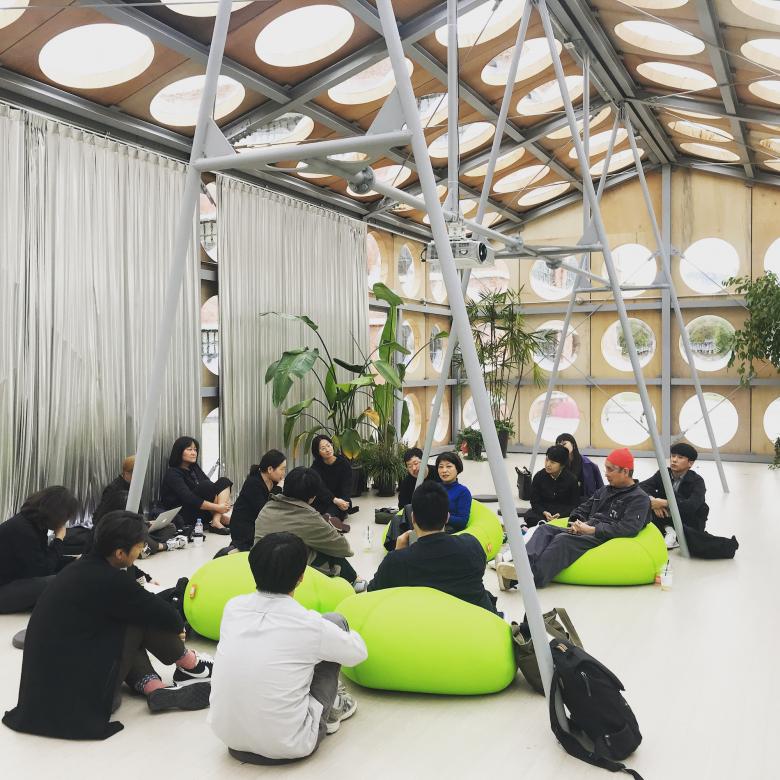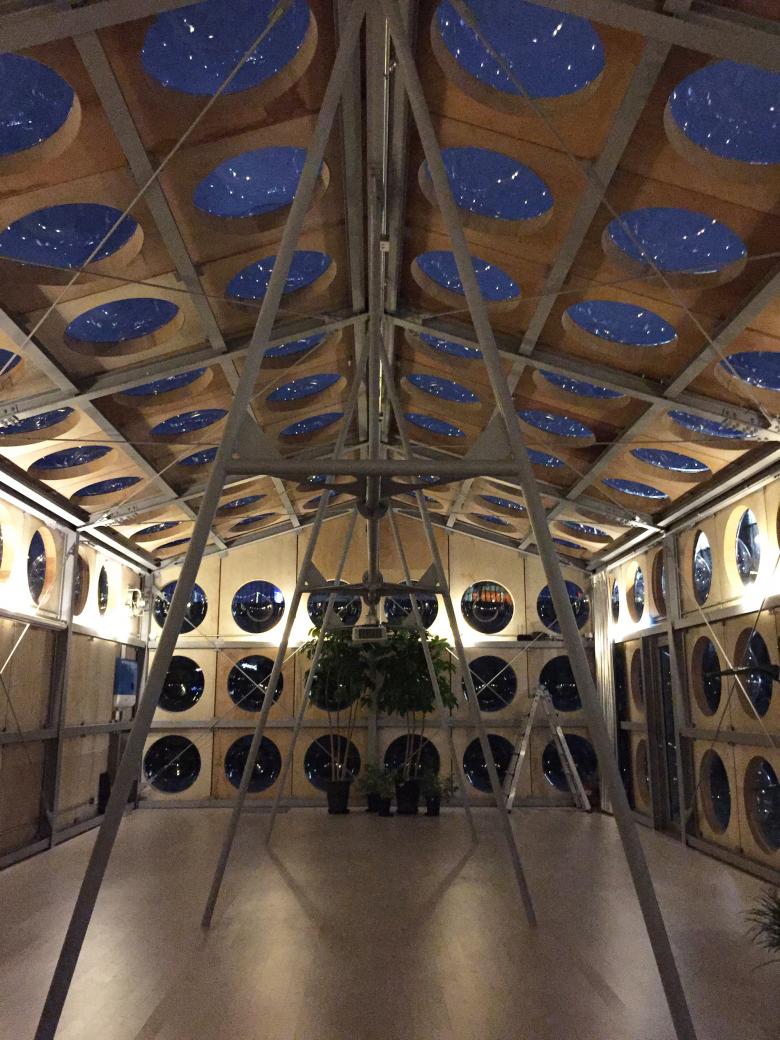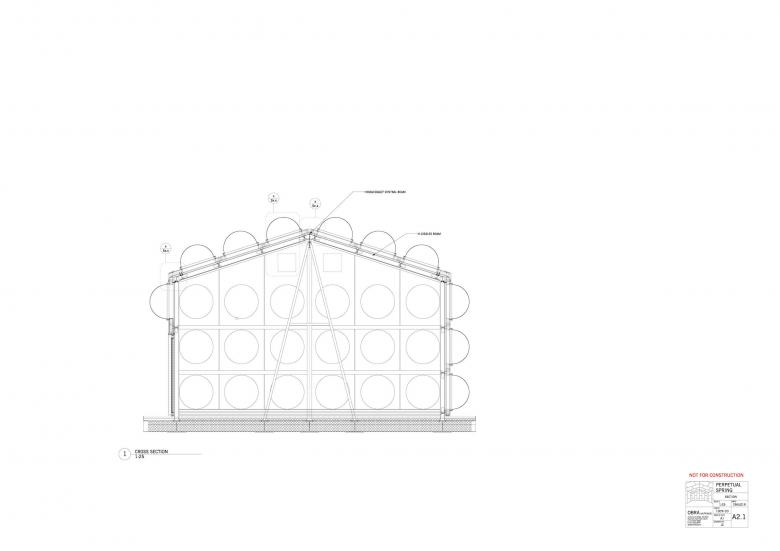Perpetual Spring Pavilion
Obra Architects
9. februari 2021
Photo: KyungRoh
Obra Architects' Perpetual Spring Pavilion occupied the courtyard in front of the Museum Of Modern and Contemporary Art (MMCA) in Seoul from from September 2019 to April 2020.
Location: Seoul, Korea
Client: The National Museum of Modern and Contemporary Art, Korea
Design Team:
- Obra Architects, Pablo Castro, Jennifer Lee, Jinkyung Cho, Lianyuan Ye, Margherita Tommasi, Danchu Cho, Yifan Deng, Alejandra Ahrend, Ruby Kang, Song Gan
- Front Inc., Michael Ra, Hwan Kim
- Moohan Global, Sang Jun Kim
- Mahadev Raman, Arup, Princeton University
- Dongsimwon Landscape & Design Construction Co., Gye Dong Ahn, Namjin Lee
- Supermass Studio, Taewook Cha
- Alan Woo
- O-un
- Professor Alex Taek-Gwang Lee, Kyunghee University
- Professor Sebastian Seung, Princeton University, Samsung NY AI Lab
- Cameron Beccario
- Sangam Lee, Namhyundang Guesthouse
Photo: KyungRoh
The year 2019, the 50th anniversary of the Museum Of Modern and Contemporary Art (MMCA), coincided with the centennial birth of an ongoing revolution: the establishment of the Korean Provisional Government in Shanghai on April 11, 1919. Architecture and Heritage: Unearthing Future connected outdoor spaces at the heart of the city’s center and provided a platform for commissioned architects to reflect upon Seoul’s modern heritage while highlighting issues facing urban life today and the future. Obra Architects was commissioned in early 2019 and conceived of Perpetual Spring Pavilion to occupy the museum's front courtyard from September 2019 to April 2020. The accompanying website platform is ongoing.
Photo courtesy of Obra Architects
The Climate-Correcting Machine: Architectural Prototype of Urban Community GatheringThe Perpetual Spring Pavilion served as a one-of-a-kind prototype showcasing the functional aspects of urban community gathering: a building as an artificially-controlled greenhouse machine to address and bring attention to a pressing global issue of our time: climate change. Combining form and destination with function, the Pavilion was proposed as a “Climate-Correcting Machine,” a platform for awareness and an invitation to action, both physical and virtual. Perpetual Stream, a realtime display and view of Perpetual Spring from the museum lobby cam, was launched upon the physical opening in Seoul, and archived viewing continues online despite early closure of the pavilion interior to the public due to covid. The open public space of the courtyard enabled visitors to the installation’s exterior throughout its physical life until it was dismantled in April of 2020.
Photo courtesy of Obra Architects
Offering a place of comfort during days of severe weather, the Pavilion was a free open access venue for a variety of public uses including: public lectures, poetry readings, theater, music, dance performances, discussion groups of all kinds, book club sessions, etc. All who are interested were invited to sign up online to use the space during open museum hours. Special guests were invited to talk about issues related to the intersection between the emergency global climate crisis and the prospects for the unlikely rise of authentic democratic rule and universal justice.
The Perpetual Spring installation aspired to artificially perpetuate, into the fall and winter, the climatic conditions propitious to progressive social change, artificially creating the kind of weather that invites to human interaction, community organization and the debate of ideas: clear skies, pleasant temperatures and abundant flowering greenery.
Photo courtesy of Obra Architects
And so it is by way of a machine that we can then attempt to prefigure both, some kind of future and its denial at the same time. If the prevalent economic system has provided storage of the efforts of the many for the benefit of the few, the machine is both empowerment and substitute of human agency towards the transformation of the world into a home. It should come as no surprise then, that the anticipated fundamental presence in the coming city of impersonalized artificial intelligence is still that of the machine. The unfulfilled promise of modernity in general, and of the Modern Movement in architecture in particular, is that of finally gaining control over the time of our lives, freedom from labor and the possibility to pursue our self-realization and finally attempt to become who we really should have been. The machine is the preeminent tool in that struggle. Perpetual Spring is then intended as both concrete and abstract machine, as a place where the very real parameters of a weather gone awry can be rudimentarily tweaked both as modest example and proposed symbolic ritual, and as the repository collective efforts towards a meta-technology, if the rightful ownership of people’s machines has been confiscated in obsessive fixation with individualism—the antidote for fear— new machines shall be invented through a popular effort towards an alternative technology.
Photo: KyungRoh
Photo courtesy of Obra Architects
Photo courtesy of Obra Architects
Photo courtesy of Obra Architects
Photo courtesy of Obra Architects
Drawing: Obra Architects
Floor Plan (Drawing: Obra Architects)
Reflected Ceiling Plan (Drawing: Obra Architects)
Transverse Section (Drawing: Obra Architects)
Longitudinal Section (Drawing: Obra Architects)
Panel Types (Drawing: Obra Architects)
Bubble Details (Drawing: Obra Architects)
Gerelateerde artikelen
-
Perpetual Spring Pavilion
on 09-02-2021
















